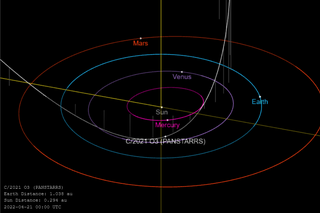| Discovery | |
|---|---|
| Discovered by | Pan-STARRS |
| Discovery date | 26 July 2021 |
| Orbital characteristics | |
| Epoch | 2021-Aug-21 |
| Observation arc | 53 days |
| Number of observations | 279 |
| Orbit type | Oort cloud |
| Perihelion | 0.287 AU |
| Eccentricity | 1.00005 (epoch 1950) 1.002 (epoch 2021) 1.0001 (epoch 2100) |
| Inclination | 56.75° |
| Longitude of ascending node | 189.03° |
| Argument of periapsis | 299.97° |
| Last perihelion | 21 April 2022 |
| TJupiter | 0.446 |
| Earth MOID | 0.062 AU |
| Jupiter MOID | 2.16 AU |
| Comet total magnitude (M1) | 10.6 |
C/2021 O3 (PanSTARRS) is perhaps an Oort cloud comet, discovered on 26 July 2021 by the Pan-STARRS sky survey. It came to perihelion on 21 April 2022 at 0.287 AU (42.9 million km). from the Sun.
The comet was expected to reach apparent magnitude 5 by late April 2022, while being only 15 degrees from the Sun. While near perihelion the comet was dimmer than expectations. It was faintly visible in STEREO/SECCHI COR2-A on 27 April 2022. Observations by Lowell Discovery Telescope on April 29 in the twilight detected a diffuse glow with a magnitude of 9 where the comet was expected to be, indicating that the comet nucleus disintegrated during perihelion. C/2021 O3 made its closest approach to Earth on 8 May 2022 at a distance of 0.60 AU (90 million km). As a dynamically new comet from the Oort cloud there was a high risk of disintegration.
The comet was recovered by multiple observatories after perihelion at magnitudes not too different from those observed pre-perihelion. Calculations carried out using the pre- and post-perihelion orbits indicate that although the comet is probably dynamically old, it may also be a fragment of a dynamically new comet that was released during the first perihelion passage of its parent comet.
Orbit

With a short observation arc of 7 days, the Minor Planet Center used an assumed eccentricity of 1.0 for the orbit solution. Due to statistics of small numbers, with a short 10 day arc JPL had an eccentricity of 0.99595±0.00444 which could be as high as 1.00039 or as low as 0.99151. With an observation arc of 53 days, JPL Horizons shows both an inbound and outbound eccentricity greater than 1.
C/2021 O3 probably took millions of years to arrive from the outer Oort cloud and, had it survived, may have been fated to be ejected from the Solar System. This is also the most likely scenario when considering the post-perihelion orbit determination of the surviving object.
References
- ^ "JPL Small-Body Database Browser: C/2021 O3 (PANSTARRS)". Jet Propulsion Laboratory. Retrieved 28 September 2021.
- ^ "JPL Horizons On-Line Ephemeris for 2021 O3 at epoch 1950 and 2100 (barycentric)". JPL Horizons On-Line Ephemeris System. Jet Propulsion Laboratory. Retrieved 29 September 2021. Solution using the Solar System Barycenter. Ephemeris Type:Elements and Center:@0 (To be outside planetary region, inbound epoch 1950 and outbound epoch 2100. Aphelia/orbital periods defined while in the planetary-region are misleading for knowing the long-term inbound/outbound solutions.)
- "Electronic Telegram No. 5009". Central Bureau Electronic Telegrams. 1 August 2021.
- "C/2021 O3 ( PanSTARRS )". Seiichi Yoshida.
- C/2021 O3 (PANSTARRS) was faintly visible
- Zhang, Qicheng; Ye, Quanzhi; Farnham, Tony L.; Holt, Carrie E. (2 May 2022). "ATel #15358: Disintegration of Near-Sun Comet C/2021 O3 (PANSTARRS)". The Astronomer's Telegram. Retrieved 8 May 2022.
- "Closest Approach to Earth 2022" (Closest Earth approach occurs when deldot flips from negative to positive). JPL Horizons. Retrieved 2021-09-29.
- Machholz, Donald (5 May 2022). "EarthSky | Darn! Comet C/2021 O3 PanSTARRS has disintegrated". earthsky.org.
- ^ Evangelista-Santana, M.; De Prá, M.; Carvano, J. M.; de la Fuente Marcos, C.; de la Fuente Marcos, R.; Alarcon, M. R.; et al. (20 July 2023). "Borderline hyperbolic comet C/2021 O3 (PANSTARRS) was fading as it approached the Sun". Monthly Notices of the Royal Astronomical Society. 524 (2): 2733–2740. arXiv:2307.10029. Bibcode:2023MNRAS.524.2733E. doi:10.1093/mnras/stad2111.
- "MPEC 2021-P05 : COMET C/2021 O3 (PANSTARRS)] (7-day arc)". Minor Planet Electronic Circulars. Minor Planet Center. 1 August 2021.
- Archive of JPL #2 (with a 10 day arc)
External links
- C/2021 O3 at the JPL Small-Body Database
| 2022 in space | ||
|---|---|---|
| Space probe launches |
|   |
| Impact events | ||
| Selected NEOs | ||
| Discoveries | ||
| Comets | ||
| Space exploration | ||

